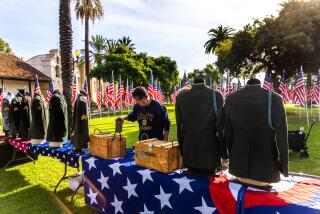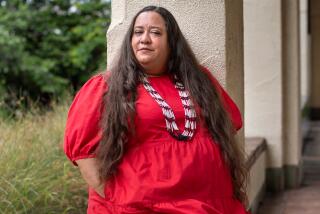2 Sides Seek Relics of Battle
- Share via
Today marks the 100th anniversary of the Battle of Balangiga, an event that will go mostly unnoticed in California.
Yet for Filipino Americans living here, it resurrects complicated feelings about the nature of ethnic identity and patriotism--made even more complicated by the events of the last few weeks.
A group of Filipino Americans will mark the centenary today near a Wyoming military base that has an unexpected connection to the battle. But Hermie and Ludy Ongkeko will not be among them. The terrorist attacks of Sept. 11 forced them, along with other leaders of California’s Filipino community, to cancel travel plans.
But the Ongkekos remain resolute in finding a resolution to a long-standing dispute that has pitted Filipinos here and in the Philippines against American veterans and U.S. officials.
“It’s heart-rending,” Ludy Ongkeko said. “We don’t want to harbor ill feelings, especially now. But something should happen.”
The focus of their dispute: two cast-iron church bells that have been displayed in Cheyenne, Wyo., for almost a century as part of a memorial honoring American soldiers who died at Balangiga.
But for the Ongkekos and many others of Filipino descent in California--there are nearly 1 million in the state--the bells are a vivid reminder of a part of U.S. history that barely appears in textbooks: the American colonization of the Philippines.
In August 1901, 74 soldiers from Company C of the 9th Infantry, fresh from helping to quell the Boxer Rebellion in China, arrived to garrison Balangiga, a town of 3,300 people about 380 miles southeast of Manila on Samar Island. The United States had annexed the Philippines in 1898 after the Spanish-American War. The soldiers, with the cooperation of local officials, used the town hall as a headquarters and a convent as their barracks.
On Sept. 28, 1901, at 6:20 a.m., at least one of the bells in the local Catholic church unexpectedly began to ring. At that signal, guerrillas fighting for freedom from the Americans launched an attack that left almost two-thirds of the company dead.
In retaliation, U.S. Brig. Gen. Jacob Smith ordered his troops to reduce the island to “a howling wilderness.”
“The more you kill and burn,” he told them, “the better you will please me.”
In the following weeks, U.S. soldiers killed most male residents of Balangiga over the age of 10. Estimates of the Filipino dead ranged widely, from 5,000 to 200,000, but historians agree that thousands were killed. Smith was eventually convicted of misconduct in a court-martial and cashiered.
A Memorial to Americans
The two bells were brought to Ft. Russell in Cheyenne, the home of the soldiers stationed on Samar, in 1904 and installed as part of a memorial to the Americans killed at Balangiga. The fort became an Air Force base in 1949 and was renamed for Francis E. Warren, Wyoming’s first governor and senator.
Mark Pulido, a 32-year-old Cerritos resident, learned about the battle, and the fate of the bells, while at UCLA, in a class on U.S.-Philippine relations. For Filipino Americans like him, born in this country, the bells are a powerful symbol of psychological wounds that still permeate the U.S.-Philippine relationship and color the ongoing dispute about veterans benefits for Filipinos who fought for the United States during World War II.
“It’s timely to reflect on the bells of Balangiga,” he said. “But what’s of more critical importance is focusing on the unresolved matter of World War II veterans.”
The Ongkekos, who lived through World War II in the Philippines, say stories of the U.S. occupation of their homeland remind them of the Japanese occupation of the islands half a century later. They think of the bells as war booty, and have been working to return them to Balangiga.
Hermie Ongkeko has tracked the bells since he was deputy director of the Philippine Presidential Security Agency under Diosdado Macapagal, who was president of the Philippines from 1961 to 1965. After Macapagal visited the town, Ongkeko began to learn bits and pieces of the history of the bells.
“To Americans, [the Battle of Balangiga] was an insurrection; to Filipinos, it was a defense of their homeland,” Ongkeko said. “I wanted to know what had triggered the ire of the Filipinos.”
His wife, sitting next to him in their living room, answered his question even as he posed it: “The Americans considered us subhuman.”
Hermie and Ludy, now American citizens, became involved in the U.S. based-movement to return the bells through their friend Rodel E. Rodis, a San Francisco lawyer and a columnist for the Philippine News.
Rodis heads a task force that has been working with the Wyoming American Legion to organize today’s ceremonies in Cheyenne. The event is not a protest to demand the bells’ return: A wreath will be laid at the memorial to honor the dead on both sides. The bishop of Cheyenne will preside at a memorial Mass at a nearby church.
Like the Ongkekos, Rodis had planned to attend the ceremony, but recent security measures have closed the base to anyone without a U.S. military ID.
Rodis said the U.S. government should return the bells to the Catholic church.
Pulido suggests a similar resolution. “There were atrocities on both ends, but what’s important is to be able to move forward,” Pulido said.
“The bells’ remaining as a prize of war doesn’t go toward healing the wounds of 100 years ago. I think that returning them to the rightful place--the church there--would help put closure to that bloody chapter in U.S.-Philippine relations.”
Returning one or both bells has been pushed by Filipinos here and abroad for almost 10 years. In 1998, Philippine President Fidel Ramos proposed to President Bill Clinton that each country be allowed to keep one original bell and one replica. But American veterans groups--championed by Sen. Craig Thomas (R-Wyo.)--opposed the idea.
Joe Sestak, a retired Air Force colonel and head of the Wyoming American Legion’s bell committee, said the bells were used as weapons of war and should remain in Cheyenne as “a memorial to soldiers who gave their lives and served their country.”
3rd Bell May Pave Way for Deal
But recent research by Jean Wall, the daughter of the last American survivor of the battle and a member of the Balangiga Research Group, has cast the Cheyenne bells’ role in the battle in doubt. A third, smaller bell, housed on a U.S. base in South Korea, may have actually sounded the attack. That bell, Wall said, may offer a way to find a compromise.
“The U.S. is now in possession of three bells that are of little value to the U.S. but to the people of Balangiga are like their liberty bells,” she said.
Today there will be two ceremonies: one in Cheyenne and one in Balangiga.
Wall, speaking from the Philippines, said she is proud to serve, along with her brother, as American representatives at the Balangiga event.
“It is right for us to be here, representing the fallen American dead, and for the members of the Filipino community to be in Cheyenne to commemorate the Filipino part in this engagement.”
San Francisco lawyer Rodis is not so optimistic. “We met in February, making plans for this week’s events,” he said. “Then Sept. 11 happened, and the world changed. Suddenly, it’s not important anymore.”
Still, he said, “the Philippine government spent a lot of money in 1998 to build a belfry for the return of the bells. There’s a belfry in Balangiga that’s awaiting two bells.”
*
Times staff writer Soraya Sarhaddi Nelson contributed to this report.
More to Read
Sign up for Essential California
The most important California stories and recommendations in your inbox every morning.
You may occasionally receive promotional content from the Los Angeles Times.













